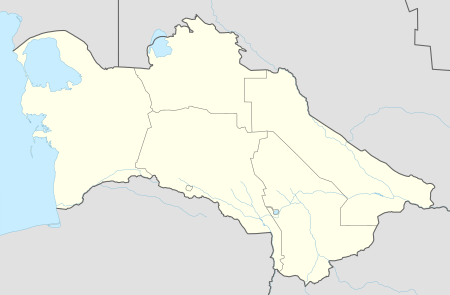Tejen
Tejen (older spellings: Tedzhen, Tejend, Tejent) is an oasis city in the Karakum Desert, in Ahal Province of Turkmenistan. It lies along the M37 highway, between Dushak and Mary, 223 kilometres (139 mi) by road southeast of Ashgabat.[1] It has a population of approximately 52,000. To the east is the larger oasis of Merv.
Tejen | |
|---|---|
 Tejen Location in Turkmenistan | |
| Coordinates: 37°23′N 60°30′E | |
| Country | |
| Province | Ahal Province |
| Elevation | 161 m (528 ft) |
| Population | |
| • Total | 52,000 |
The town contains the Charman Ahun Mosque, the Hotel Tejen, and numerous fertiliser and textiles factories.
History
In 1883 it was occupied by General Komarov during the Russian conquest of Turkestan. In 1916, when the Turkmens participated in a revolt against the Russians, Tejen was a hotbed of activity.[2]
Economy
Tejen is known for its melon production, and contains numerous fertiliser and textiles factories. It is also known for its narcotics, which are known locally as "Tejen tea".[3]
Landmarks
The town contains the Charman Ahun Mosque and the Hotel Tejen.[3]
Wildlife
Historical records indicate that the Caspian tiger occurred in this region.[4]
Transport
It is a stop on the Trans-Caspian railway, and in the 1996 a new line to Mashhad in Iran was opened.[3]
See also
- Railway stations in Turkmenistan
References
- Google (9 October 2016). "Tejen" (Map). Google Maps. Google. Retrieved 9 October 2016.
- "Turkenistan". Encyclopædia Britannica. Retrieved 8 October 2016.
- Brummell, Paul (2005). Turkmenistan. Bradt Travel Guides. pp. 129–30. ISBN 978-1-84162-144-9.
- Geptner, V. G., Sludskij, A. A. (1992) [1972]. "Tiger". Mlekopitajuščie Sovetskogo Soiuza. Moskva: Vysšaia Škola [Mammals of the Soviet Union. Volume II, Part 2. Carnivora (Hyaenas and Cats)]. Washington DC: Smithsonian Institution and the National Science Foundation. pp. 95–202.CS1 maint: multiple names: authors list (link)